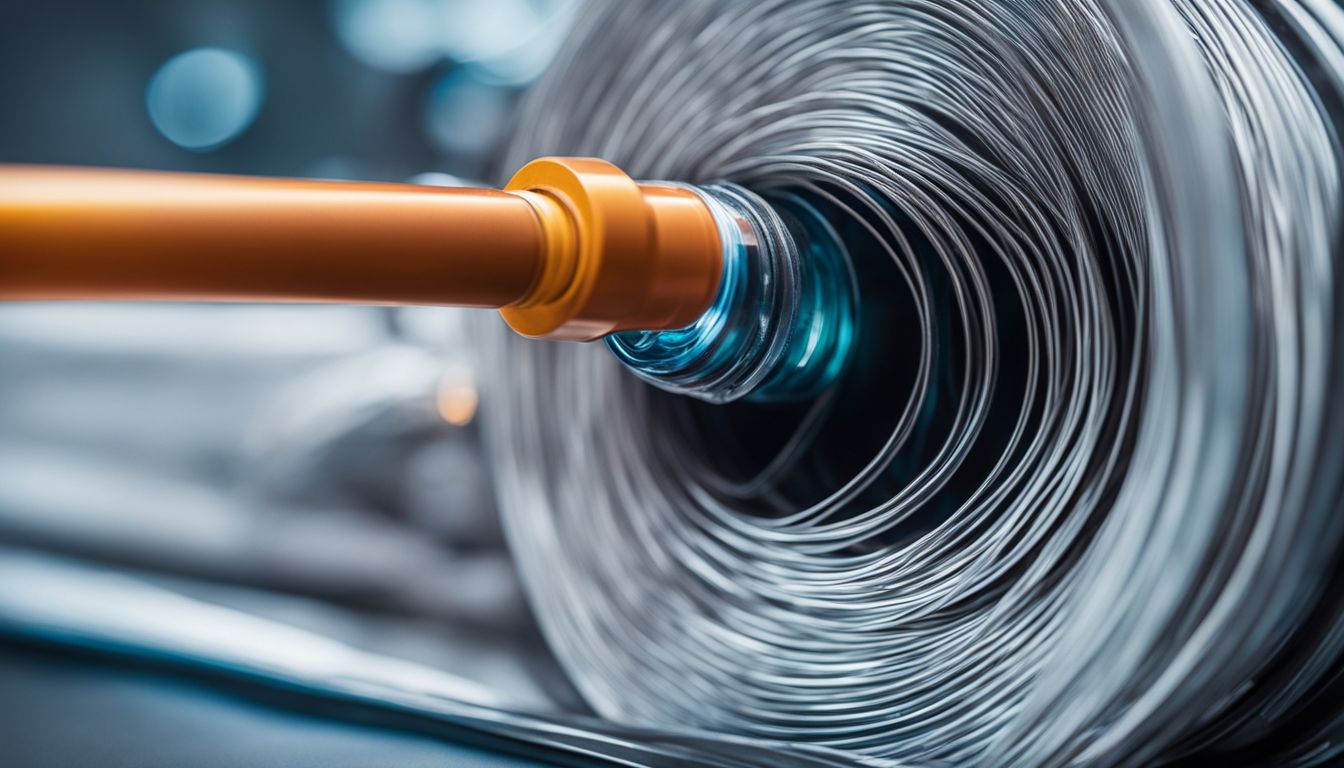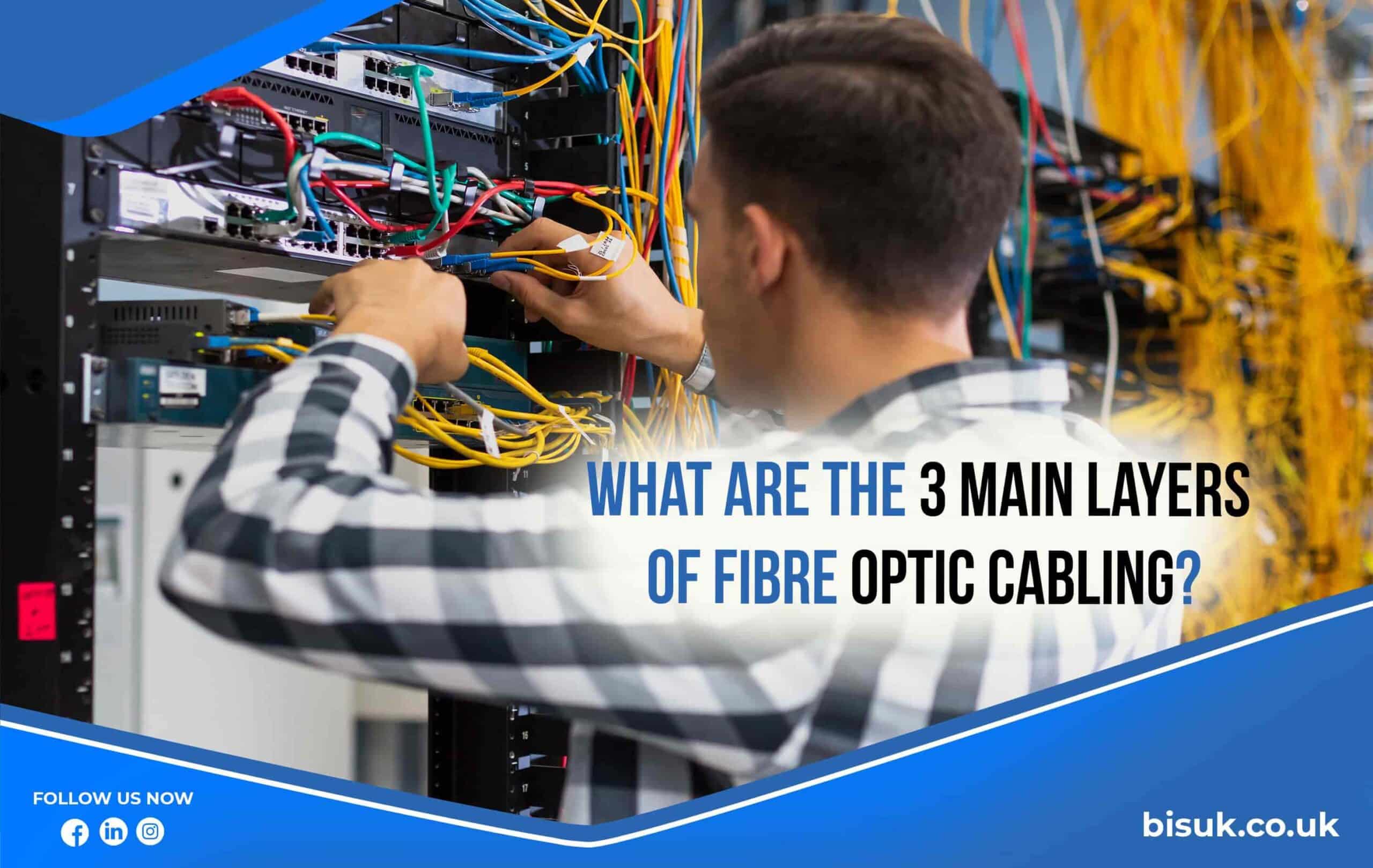Struggling to understand the complexity of fiber optic cables? These high-tech threads are revolutionizing how we communicate, zipping data at the speed of light. This post will unravel the mystery of fiber optics by exploring their three main layers—core, cladding, and coating—to show you why they’re so essential for lightning-fast connections.
Dive in with us to illuminate your understanding!
Key Takeaways
- Fiber optic cables are made of three parts: the core, cladding, and coating. The core carries light to send data, while the cladding keeps it on track. The coating protects these inner layers from damage.
- There are two types of fiber optic cables: single-mode and multimode. Single-mode fibers carry light straight down for long distances without losing signal quality. Multimode fibers can transfer multiple light signals over shorter distances.
- Standards from organizations like TIA and ITU guide how fiber optic cables should be made and used. These standards help make sure that communication stays fast and clear over long distances.
Understanding Fiber Optic Cables

Fiber optic cables carry signals with light instead of electricity. They move data at high speeds over long distances. These cables are made of glass fibers thinner than a human hair.
Inside these thin strands, light bounces back and forth to send messages.
These special cables come in two types: single-mode and multimode fiber. Single-mode carries one light beam directly down the center. This allows it to travel far without losing quality.
Multimode carries many beams that bounce around, making it better for short distances. Both types use the magic of total internal reflection to keep light inside the cable.
Each fiber optic strand has three main parts: core, cladding, and coating. The core is where the light travels through. Cladding wraps around the core and reflects light back into it, which keeps signals strong as they zip along.
A tough outer coating protects against damage or interference from outside sources.
Optical fibers can be bundled together by the hundreds or even thousands in one cable! This way, lots of information can pass all at once—like a super-fast digital highway! Fiber optics make things like internet browsing and streaming TV quick and smooth because they’re much faster than old copper wires.
Core Component of Fiber Optic Cables

The core is the heart of a fiber optic cable. Made mostly of glass, it carries light signals over long distances. Plastic cores exist too, but they’re less common. Think of the core as a very thin straw made of super pure silicon dioxide.
This material has to be clear so that light can travel through without much loss.
Cores come in different sizes depending on their use. For single-mode fibers, which send light straight down the middle, cores are tiny – about 8 to 10 microns across. That’s even thinner than a human hair! Multimode fibers have bigger cores, ranging from 50 to 62.5 microns wide.
They allow light to bounce around inside more because they’re used for shorter distances where signal strength doesn’t drop off too fast.
Cladding Layer in Fiber Optic Cables
Cladding is a crucial part of optical fiber cables. It sits right around the core and has a big job. The cladding keeps the light signals inside the core where they belong. This happens because its refractive index is less than that of the core, which makes light bend back in.
Optical data signals rely on this layer to move smoothly through the cable without losing their way. Cladding’s standard sizes are 125µm or 140µm, but it’s super thin nonetheless.
Think of it as an invisible guide; although you can’t see it, cladding makes sure your data gets to its destination fast and accurately—every single time.
Coating: The Protective Layer
The coating acts like armor for the fiber optic cable. It keeps the inner parts safe from scratches, moisture, and other harm. Picture the core and cladding as a person; the coating is like their tough jacket that shields them from bad weather.
This layer can handle different conditions because it comes in various types such as acrylate or polyimide.
Acrylate coatings are common—they’re a bit like plastic wrap over leftovers to keep them fresh. Polyimide, on the other hand, works well in hot spots; think oven mitts for handling hot pans.
The protective layer isn’t just one size—it can be thick or thin based on what’s needed, from 250 to 900 microns wide. Adding Kevlar® fibers makes sure that even if things get rough—like during installation—the delicate core inside stays uncrushed and intact.
The Interplay and Function of the Three Layers
6. The Interplay and Function of the Three Layers:.
Dive into the symphony of science that orchestrates fiber optic performance; each layer plays a critical role, harmonizing to ensure clear, efficient data transmission. It’s here we’ll explore how these components—core, cladding, and coating—collaborate to protect and propel light down this technological thoroughfare.
Transmission of Light in Core
Light travels through the core of a fiber optic cable. The core is its smallest part but is super important. It’s usually made of glass or plastic. Think of the core as a very thin straw that light zooms down.
Single mode fibers let only one type of light pass at a time. This means they can send signals really far without mixing them up or losing quality. Multimode fibers are different because they can send lots of light types all at once, but not as far as single mode fibers can go.
Using the right kind of fiber depends on how far and how clear you need your signal to travel.
Reflection and Confinement in Cladding
Cladding is the superhero cape for the core of fiber optic cables. It hugs the core tightly and has a magical power: it bounces light back in. This keeps your data zooming along without getting lost or fuzzy.
Imagine light as a bunch of tiny, speedy cars on a race track that’s wrapped in cladding; they can zip around turns without flying off into space.
The cladding does more than just reflect; it’s like a tough bodyguard with an important job. It wraps around the core to protect those precious light signals from escaping out into the cable wilderness where they could fade away or get mixed up with other signals, causing confusion.
Cladding makes sure that information travels fast and reaches where it needs to go safely, thanks to its clever design and lower refractive index compared to the core’s material.
Protection Offered by the Coating
The coating on an optical fibre cable acts like armor, shielding the sensitive inner parts. It’s made from tough materials like acrylate or polyimide that block harm from outside forces.
This protective layer can range in thickness, usually between 250 to 900 microns.
It also keeps the fibre strong during installation and use. For example, Kevlar® fibers wrap around to prevent crushing or damage when you pull the cables through conduits or innerducts.
The right coating ensures fiber optic cables last long under all sorts of conditions whether they are inside buildings or buried underground.
Standards for Fiber Optic Cabling
Organizations like TIA and ITU set rules for fiber optic cabling to make sure everything works well together. These standards help with choosing the right connectors and gear. ANSI/TIA-568-C.3, ITU-TG.653, ITU-TG.655, and ITU-T G.657 are some you might hear about a lot.
They are important because they keep signals strong over long distances in things like undersea cables or local area networks. Following these guidelines helps avoid problems that can slow down the light as it travels through the fibers, which is key for fast communication without errors.
Conclusion
Fiber optic cables are the highways of our modern communication. The core, cladding, and coating work together like a team. They make sure signals travel fast and arrive safely. Each layer has its own critical role in keeping data zooming along at the speed of light.
These three layers ensure that every message, video call, or streamed song reaches you crystal clear.
So, if you need assistance with your cabling, contact us at info@britanniaitsolutionsuk.co.uk because we provide end-to-end technical support.
FAQs
1. What are fiber optic cables made of?
Fiber optic cables consist mainly of silicon dioxide (SiO2), a transparent material which allows light to pass through for optical communication.
2. Can you explain the three layers in fiber optic cabling?
Sure! The innermost part is the core, where light travels. Surrounding it is the cladding, which keeps light inside the core. Lastly, there’s a protective cable jacket around everything.
3. What’s different between single-mode and multimode fiber?
Single-mode fibers let light travel straight down one path with little latency—it’s great for long distances. Multimode fibers have bigger cores and let light bounce around, fine for shorter runs.
4. Why do we need strengthening fibres in our cables?
Strengthening fibers protect against physical stress—they’re heroes that save your data from getting interrupted by breaks or bends in the cable!
5. How do patch cords work with these cables?
Patch cords connect devices using short lengths of fiber-optic cable; they’re like quick bridges linking electronics to networks or other gear.
6. Are all optical fibers clear and colorless?
Yes, most fibers are colorless—like looking through clean glass—but cables can come wrapped up in different colors for easy identification during wiring and splices.










